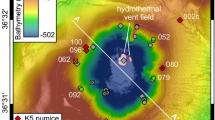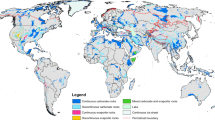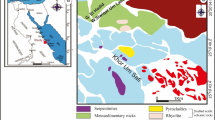Abstract
Thermal waters of the Usak area have temperatures ranging from 33 to 63°C and different chemical compositions. These waters hosted by the Menderes Metamorphic rocks emerge along fault lineaments from two geothermal reservoirs in the area. The first reservoir consists of gneiss, schists, and marbles of the Menderes Metamorphic rocks. The recorded reservoir is Pliocene lacustrine limestone. Hydrogeochemical studies indicate that thermal waters were mixed with surface waters before and/or after heating at depth. The results of mineral equilibrium modeling indicate that all the thermal waters are undersaturated at discharge temperatures for gypsum, anhydrite, and magnesite minerals. Calcite, dolomite, aragonite, quartz, and chalcedony minerals are oversaturated in all of the thermal waters. Water from the reservoir temperatures of the Usak area can reach upto120°C. According to δ18O and δ2H values, all thermal and cold groundwater are of meteoric origin.










Similar content being viewed by others
References
Arnorsson S, Gunnlaugsson E, Svavarsson H (1983) The chemistry of geothermal waters in Iceland. III. chemical geothermometry in geothermal investigations. Geochim Cosmoschim Acta 47:567–577
Clark ID, Fritz P (1997) Environmental isotopes in hydrogeology. Lewis Publishers, New York, p 327
Craig H (1961) Isotopic variations in meteoric waters. Science 133:1833–1834
Ercan T, Dincel A, Metin S, Turkecan A, Gunay E (1978) Geology of the neogene basins in Usak region (in Turkish). Bull Geol Soc Turkey 21:97–106
Fournier RO (1977) A review of chemical and isotopic geothermometers for geothermal systems. In: Proceedings of the symposium on geothermal energy, Cento Scientific Programme, Ankara, pp 133–143
Fournier RO (1979) A revised equation for the Na–K geothermometer. Geotherm ResCouncil Trans 3:221–224
Gat J, Carmi I (1970) Evaluation of the isotopic composition of atmospheric waters in the Mediterranean Sea area. J Geophys Res 75:3039–3048
Gemici U, Filiz S (2001) Hydrogeochemistry of the Cesme geothermal field, western Turkey. J Volcanol Geotherm Res 110:171–187
Gemici U, Tarcan G (2002a) Hydrogeochemistry of the Simav geothermal field, western Anatolia, Turkey. J Volcanol Geotherm Res 116:215–233
Gemici U, Tarcan G (2002b) Distribution of boron in thermal waters of western Anatolia, Turkey, and examples of their environmental impacts. Environ Geol 43:87–98
Giggenbach WF, Gonfiantini R, Jangi BL, Truesdell AH (1983) Isotopic and chemical composition of parbati valley geothermal discharges, NW Himalaya, Indiana. Geothermics 5:51–62
Giggenbach WF (1988) Geothermal solute equilibria derivation of Na–K–Mg–Ca geoindicator. Geochim Cosmoschim Acta 52:2749–2765
Giggenbach WF, Corrales RS (1992) The isotopic and chemical composition of waters and steam discharges from volcanic-magmatic-hydrothermal systems of the Guanacoste Geothermal Province, Costa Rica. Appl Geochem 7:309–332
IAH (International Association of Hydrogeologist) (1979) Map of mineral and thermal water of Europe, Scale 1:500 000. International Association of Hydrogeologist, London
Ica M (1979) Geology and hydrogeology investigations of Usak-Esme-Orencik spa. J Geol Eng Ankara, 37–46
Kharaka YK, Gunter WD, Affarwall PK, Perkins EH, De Braall JD (1988) SOLMINEQ (a computer program code for geochemical modelling of water–rock interactions. In: US Geological Survey Water Investigations, Report 88–4227
Mahon WAJ, Klyen LE, Rhode M (1980) Natural sodium-bicarbonate-sulphate hot waters in geothermal systems: Chinetsu. J Jpn Geotherm Energy Assoc 17:11–24
Makris J (1985) Geophysical and geodynamic implications for the evolution of the Hellenides. In: Stanley DI, Wezel FC (eds) Geological evolution of the Mediterranean basin. Springer, New York, pp 23–269
Mc Kenzie DP (1978) Active tectonics of the Alpine-Himalayan belt: the Aegean and the surrounding regions. Geophys J R Astron Soc 55:217–254
MTA (1995) Inventory of thermal and mineral waters of Turkey, Usak. MTA General Directory, Ankara
Mutlu H (1998) Chemical geothermometry and fluid-mineral equilibria for the Omer-Gecek thermal waters, Afyon area, Turkey. J Volcanol Geotherm Res 80:303–321
Mutlu H, Gulec N (1998) Hydrogeochemical outline of thermal waters and geothermometry applications in Anatolia (Turkey). J Volcanol Geotherm Res 85:495–515
Nicholson K (1993) Geothermal fluids, chemistry and exploration techniques. Springer, Berlin
Nieva D, Nieva R (1987) Developments in Geothermal Energy in Mexico, Part 12- Acationic Composition Geothermometer for Prospecting Geothermal Resources. Heat Recovery Syst 7:243–258
Qin D, Turner JV, Pang Z (2005) Hydrogeochemistry and groundwater circulation in the Xi’an geothermal field, China. Geothermics 34:471–494
Sander P (2007) Lineaments in groundwater exploration: a review of applications and limitations. Hydrogeol J 15:71–74
Shaban A, Khawlie M, Abdallah C (2006) Use of remote sensing and GIS to determine recharge potential zones: the case of Occidental Lebanon. Hydrogeol J 14:433–443
Solomon S, Quiel F (2006) Groundwater study using remote sensing and geographic information systems (GIS) in the central highlands of Eritrea. Hydrogeol J 14:729–741
Tezcan AK (1979) Geothermal studies, their present status and contribution to heat flow contouring in Turkey. In: Cermac V, Rybach L (eds) Terrestrial heat flow in Europe. Springer, Berlin, pp 283–292
Tole MP, Armannsson H, Zhong-He P, Arnorsson S (1993) Fluid/mineral equilibrium calculations for geothermal fluids and chemical geothermometry. Geothermics 22(1):17–37
Truesdell AH (1976) Summary of section III Geochemical Techniques in Explanation. In: Proceedings, Second United Nations Symposium on the Development and Use of Geothermal Resources. San Francisco, V.1, Washington DC, US Government Printing Office
Truesdell AH, Hulston JR (1980) Isotopic evidence of geothermal systems, Chapter 5. In: Fritz P, Fontes J-Ch (eds) Handbook of environmental geochemistry, the terrestrial environment, A. Elsevier, Amsterdam, pp 179–226
Verma MP (2001) Silica solubility geothermometers for hydrothermal systems. Water–Rock Interaction. Swets & Zeitlinger, Lisse, pp 349–352
Acknowledgments
The author wishes to thank Erhan Sener for technical assistance.
Author information
Authors and Affiliations
Corresponding author
Rights and permissions
About this article
Cite this article
Davraz, A. Hydrogeochemical and hydrogeological investigations of thermal waters in the Usak Area (Turkey). Environ Geol 54, 615–628 (2008). https://doi.org/10.1007/s00254-007-0829-0
Received:
Accepted:
Published:
Issue Date:
DOI: https://doi.org/10.1007/s00254-007-0829-0




